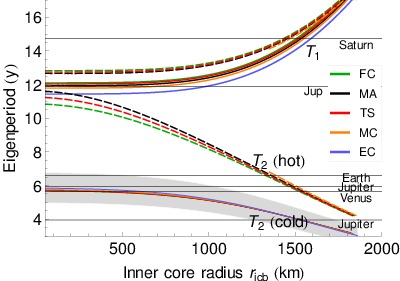Influence of an inner core on the long-period forced librations of Mercury,

The two free librations have periods between 2.5 and 18 y depending on the internal structure. We show that large amplitude long-period librations of 10's of arcsec are generated when the period of a planetary forcing approaches one of the two free libration periods.
These amplitudes are sufficiently large to be detectable by spacecraft measurements of the libration of Mercury. The amplitudes of the angular velocity of Mercury's mantle at planetary forcing periods are also amplified by the resonances, but remain much smaller than the current precision of Earth-based radar observations unless the period is very close to a free libration period.
The inclusion of mantle-inner core coupling in the rotation model does not significantly improve the fit to the radar observations.
This implies that it is not yet possible to determine the size of the inner core of Mercury on the basis of available observations of Mercury's rotation rate. Future observations of the long-period librations may be used to constrain the interior structure of Mercury, including the size of its inner core.
Yseboodt, M., A. Rivoldini, T. Van Hoolst and M. Dumberry,
Influence of an inner core on the long-period forced librations of Mercury,
Icarus, Vol 226, p41-51, 2013.
Analytical model of the long-period forced longitude librations of Mercury
|
The
shaking of Mercury’s orbit by the planets forces
librations in longitude in addition to those at
harmonics of the orbital period that have been
used to detect Mercury’s molten core. We extend
the analytical formulation of Peale et al.
(Peale, S.J., Margot, J.L., Yseboodt, M. [2009].
Icarus 199, 1–8) in order to provide a
convenient means of determining the amplitudes
and phases of the forced librations without
resorting to numerical calculations. We derive
an explicit relation between the amplitude of
each forced libration and the moment of inertia
parameter B-A/Cm. Far from resonance with the
free libration period, the libration amplitudes
are directly proportional to B-A/Cm. Librations
with periods close to the free libration period
of ~12 years may have measurable (~arcsec)
amplitudes. If the free libration period is
sufficiently close to Jupiter’s orbital period
of 11.86 years, the amplitude of the forced
libration at Jupiter’s period could exceed the
35 arcsec amplitude of the 88-day forced
libration. We also show that the planetary
perturbations of the mean anomaly and the
longitude of pericenter of Mercury’s orbit
completely determine the libration amplitudes.
While these signatures do not affect spin rate
at a detectable level (as currently measured by
Earthbased radar), they have a much larger
impact on rotational phase (affecting imaging,
altimetry, and gravity sensors). Therefore, it
may be important to consider planetary
perturbations when interpreting future
spacecraft observations of the librations.
|
Resonant forcing of Mercury's libration in longitude
Peale S. J., Margot J.L. and Yseboodt M.,
Resonant forcing of Mercury's libration in longitude,
Icarus, Vol 199, Pages 1-8, doi: 10.1016/j.icarus.2008.09.002, 2009.

Evolution of Mercury's obliquity
Mercury has a near-zero obliquity, i.e. its spin axis is nearly perpendicular to its orbital plane. The value of the obliquity must be known precisely in order to constrain the size of the planet's core with the framework suggested by Peale (1976). Rambaux and Bois (2004) have suggested that Mercury's obliquity varies on thousand-year timescales due to planetary perturbations, potentially ruining the feasibility of Peale's experiment.
We use a Hamiltonian approach (free of energy dissipation) to study the spin-orbit evolution of Mercury subject to secular planetary perturbations. We can reproduce an obliquity evolution similar to that of Rambaux and Bois (2004) if we integrate the system with a set of initial conditions that differs from the Cassini state. However the thousand-year oscillations in the obliquity disappear if we use initial conditions corresponding to the equilibrium position of the Cassini state. This result indicates that planetary perturbations do not force short-period, large amplitude oscillations in the obliquity of Mercury.
In the absence of excitation processes on short timescales, Mercury's obliquity will remain quasi-constant, suggesting that one of the important conditions for the success of Peale's experiment is realized.
We show that interpretation of data obtained in support of this experiment will require a precise knowledge of the spin-orbit configuration, and we provide estimates for two of the critical parameters, the instantaneous Laplace plane orientation and the orbital precession rate from numerical fits to ephemeris data.
Finally we provide geometrical relationships and a scheme for identifying the correct initial conditions required in numerical integrations involving a Cassini state configuration subject to planetary perturbations.
Yseboodt, M.and Margot, J. L.,
Evolution
of Mercury's Obliquity,
Icarus
Volume 181, Issue 2, Pages 327-337,
doi:10.1016/j.icarus.2005.11.024, 2006.